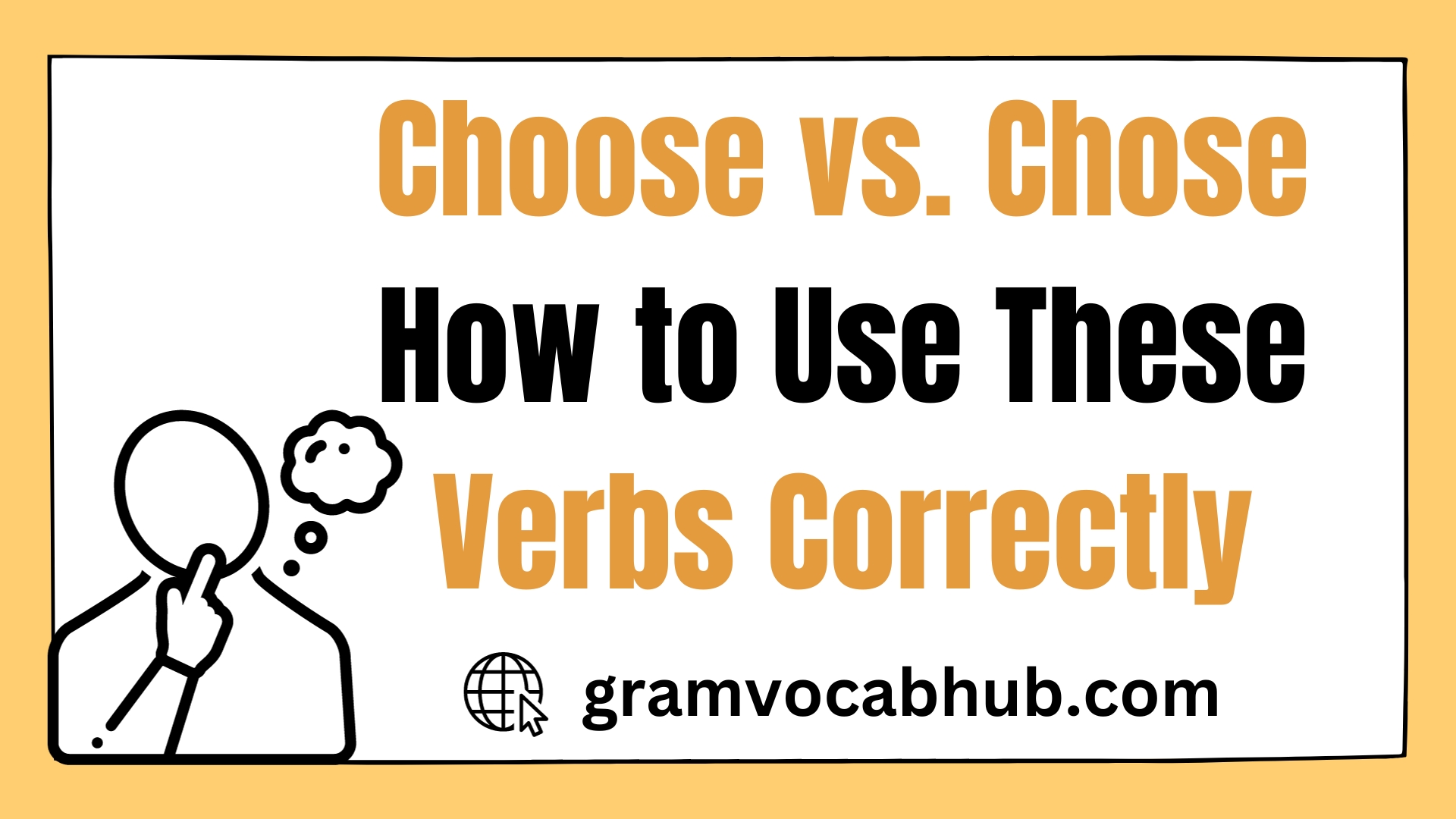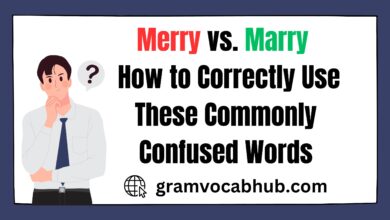Understanding when to use “choose” versus “chose” can be confusing for writers. While the two words sound alike phonetically, they actually have distinct usages. Applying choose and chose properly ensures writing clarity and demonstrates a command of language.
This article will explain the exact difference between choose and chose, when to use each, and how to remember which is which. You’ll eliminate mix-ups and gain confidence applying choose and chose correctly going forward.
Introduction
As complete homophones – words with different meanings that sound alike – choose and chose cause understandable mix-ups in writing. After all, English teems with inconsistent rules that overwhelm even native speakers.
However, the choose vs. chose decision rule remains straightforward:
- Choose signals something actively being selected in the current moment.
- Chose refers to something already elected in the past.
Choose relates to a decision occurring now while chose refers to a prior determined choice. Learning this key distinction enables deploying each properly.
Beyond sounding more literate by choosing choose over chose situationally, distinguishing the two also forges clearer communications. Using chose when relating an ongoing decision garbles meaning by implying actions already completed. Writers should actively choose choose or chose based on context.
Recognizing Choose vs. Chose Importance
Mistaking choose and chose appears like a harmless typo, but consistently misapplying them has consequences:
Undermines Credibility
When writers misuse basic language conventions, readers question their authority and grasp of the subject matter. Erratic grammar or spelling lapses diminish trust.
Interrupts Flow
Since chose refers to completed actions, using it for present situations makes sentences jagged and disjointed. Readers must recalibrate to understand intended meaning.
By taking care to mindfully choose choose or chose, writers present polished, professional communications.
When to Use “Choose”
The first step toward reliably deploying choose and chose properly involves learning when specifically to employ choose based on its definition and usage:
Definition and Usage
Choose is a verb used to indicate:
- Making a current selection between multiple options
- Currently deciding on or expressing a preference for something
It occupies the present tense for choices unfolding in real-time.
For example:
- Deciding between dining options
- Picking the next vacation destinations
- Choosing an outfit to wear
Essentially, choose refers to decision processes still underway rather than concluded. Definitions of choose include:
- Select carefully from a number of alternatives
- Determine or establish something through reasoning
- To make a decision
Choose relates to immediate, ongoing acts of choosing rather than those executed already.
Examples of Properly Using “Choose”
To build familiarity with contextual usage, here are example sentences correctly applying choose:
- I’m trying to choose the best career path after graduation.
- Let’s take some time to choose wall colors before painting the nursery.
- Mom lets me choose my clothes to wear to school now.
- Did you choose chicken or steak for dinner? I’m still deciding.
- Before publishing that post, you should choose words thoughtfully to avoid misinterpretations.
Each example sentence relates to a current decision underway rather than resolved already. Since choosing signals ongoing processes that have not yet completed actions, deploying it in the present tense context remains fitting.
When to Use “Chose”
In contrast to active, current choosing, chose indicates past decisions already made and implemented. Its definition and usage include:
Definition and Usage
The verb chose represents:
- A previous selection between options
- An earlier process of determining or expressing a preference
It appears exclusively in the past tense since the choice already occurred. For example:
- Recalling an entrée already ordered
- Referencing a one-time vacation pickup
- Explaining an outfit previously worn
Essentially, chose refers strictly to choices already completed in the past. Definitions encompass:
- Selected something previously from alternatives
- Determined or established something earlier through reasoning
Chose requires implication of a decision reached farther in the past than choose.
Examples of Properly Using “Chose”
Below are example sentences demonstrating correct applications of chose when writing:
- I chose my college major after considering career income potential.
- She chose grey with white trim when she painted her living room last year.
- Anthony chose a suit and tie to wear for yesterday’s interview.
- For her 40th birthday trip, Josie chose Paris over Rome or Madrid.
- We chose our new car mostly based on safety ratings and gas mileage.
In each case, the choice lies fully in the past rather than still pending. Since chose refers exclusively to bygone choices, situating it in past tense contexts remains fitting.
How to Remember the Difference
Having covered definitions and appropriate usage contexts for choose and chose, next, let’s explore some mnemonic devices and memory cues to cement knowledge:
Mnemonic Device
An easy way to recall whether choose or chose works better entails focusing on the double “o” in choose mapping to the present tense and the single “o” in chose to indicate the past tense:
“I choose the shoes” – Choose has two o’s like the present tense shoes
“I chose the shoes” – Chose has one o like the past tense chose
Visually linking the extra “o” in choose with present possession helps you associate it with current actions.
Think of Tense
Another route involves simply conscious connections between the words and timeframes:
Choose = present tense
Chose = past tense
Actively registering choose with present and chose with past when writing trains your brain through repetition.
Common Mistakes
Even armed with definitions and helpful tricks, choose and chose usage mix-ups still occasionally occur. Common errors include:
Using “Chose” in Place of “Choose”
It remains tempting to use chose in a present tense context since they sound identical when spoken. For example:
❌Incorrect: I’m choseing what to eat for lunch
✅Correct: I’m chooseing what to eat for lunch
Since the decision still pends in real-time, choose works better.
Using “Choose” in Place of “Chose”
Sometimes writers mistakenly indicate past choices with choose rather than the required chose:
❌Incorrect: Yesterday, he choose to take a nap
✅Correct: Yesterday, he chose to take a nap
Because the nap choice occurred wholly in the past, only chose logically aligns.
Staying actively aware of the present (choose) vs. past (chose) meaning variance prevents such cross-contamination in the future.
Conclusion
The English language certainly contains its share of odd rules and exceptions. Thankfully, choose and chose conform to fairly straightforward guidelines connected explicitly to time specificity and context.
By registering choose with present-tense, mid-decision denotation and chose solely for past resolutions, distinguishing usage cases becomes breezy. Treat choose as indicating ongoing process of choosing while chose signifies having already chosen.
Let memory links and mnemonics about Os and tense alleviate any remaining hesitation. Soon, identifying correct conditions for choose vs chose will flow naturally. Wielding language with dexterity remains a supremely empowering skill for any communicator.
Finally, don’t allow obscure conventions to intimidate further language mastery. Even seasoned wordsmiths still readily consult resources. Prioritizing improvement and precision over perfection accelerates progress.
Now that you grasp when to choose choose or chose, go forth and start applying them purposefully in your communications. What writing will you choose to craft next?
Frequently Asked Questions
Still hungry for more choose vs chose knowledge? Below find supplemental clips addressing common queries:
Is “choose” present or past tense?
Choose is exclusively the present tense form, used in relation to current, ongoing decisions rather than resolved already. Choices still pending unfold in real-time requiring choose.
Is “chose” present or past tense?
Chose conveys the past tense since it indicates choices already completed rather than pending. Any time you reference resolved decisions or finished processes from earlier times, chose works perfectly.
Can you use “chose” in a present tense sentence?
No, chose should only relate to choices made fully in the past. If trying to describe an ongoing decision or process still underway, you must use choose rather than chose in that present tense context for accuracy.

![Nouns Definition, All Types and Examples [Step By Step Complete Guide]](https://gramvocabhub.com/wp-content/uploads/2023/11/Nouns-Definition-All-Types-and-Examples-Step-By-Step-Complete-Guide-390x220.jpg)



